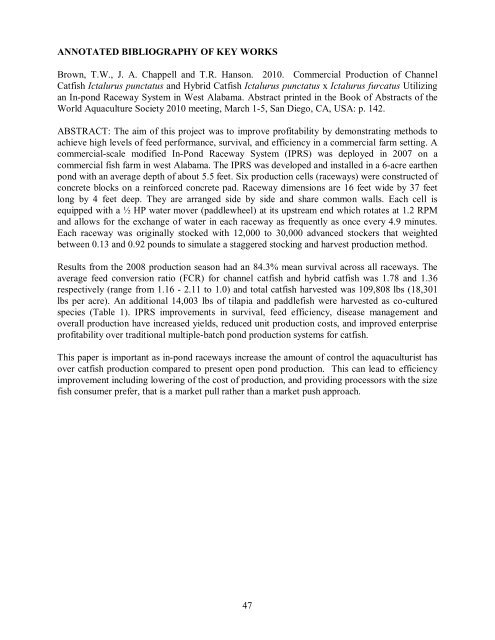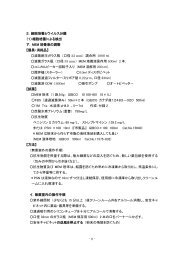Program and Abstracts(PDF)
Program and Abstracts(PDF)
Program and Abstracts(PDF)
Create successful ePaper yourself
Turn your PDF publications into a flip-book with our unique Google optimized e-Paper software.
ANNOTATED BIBLIOGRAPHY OF KEY WORKS<br />
Brown, T.W., J. A. Chappell <strong>and</strong> T.R. Hanson. 2010. Commercial Production of Channel<br />
Catfish Ictalurus punctatus <strong>and</strong> Hybrid Catfish Ictalurus punctatus x Ictalurus furcatus Utilizing<br />
an In-pond Raceway System in West Alabama. Abstract printed in the Book of <strong>Abstracts</strong> of the<br />
World Aquaculture Society 2010 meeting, March 1-5, San Diego, CA, USA: p. 142.<br />
ABSTRACT: The aim of this project was to improve profitability by demonstrating methods to<br />
achieve high levels of feed performance, survival, <strong>and</strong> efficiency in a commercial farm setting. A<br />
commercial-scale modified In-Pond Raceway System (IPRS) was deployed in 2007 on a<br />
commercial fish farm in west Alabama. The IPRS was developed <strong>and</strong> installed in a 6-acre earthen<br />
pond with an average depth of about 5.5 feet. Six production cells (raceways) were constructed of<br />
concrete blocks on a reinforced concrete pad. Raceway dimensions are 16 feet wide by 37 feet<br />
long by 4 feet deep. They are arranged side by side <strong>and</strong> share common walls. Each cell is<br />
equipped with a ½ HP water mover (paddlewheel) at its upstream end which rotates at 1.2 RPM<br />
<strong>and</strong> allows for the exchange of water in each raceway as frequently as once every 4.9 minutes.<br />
Each raceway was originally stocked with 12,000 to 30,000 advanced stockers that weighted<br />
between 0.13 <strong>and</strong> 0.92 pounds to simulate a staggered stocking <strong>and</strong> harvest production method.<br />
Results from the 2008 production season had an 84.3% mean survival across all raceways. The<br />
average feed conversion ratio (FCR) for channel catfish <strong>and</strong> hybrid catfish was 1.78 <strong>and</strong> 1.36<br />
respectively (range from 1.16 - 2.11 to 1.0) <strong>and</strong> total catfish harvested was 109,808 lbs (18,301<br />
lbs per acre). An additional 14,003 lbs of tilapia <strong>and</strong> paddlefish were harvested as co-cultured<br />
species (Table 1). IPRS improvements in survival, feed efficiency, disease management <strong>and</strong><br />
overall production have increased yields, reduced unit production costs, <strong>and</strong> improved enterprise<br />
profitability over traditional multiple-batch pond production systems for catfish.<br />
This paper is important as in-pond raceways increase the amount of control the aquaculturist has<br />
over catfish production compared to present open pond production. This can lead to efficiency<br />
improvement including lowering of the cost of production, <strong>and</strong> providing processors with the size<br />
fish consumer prefer, that is a market pull rather than a market push approach.<br />
47



